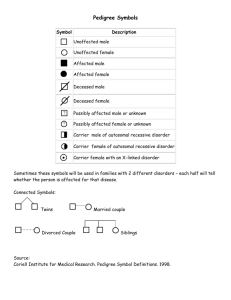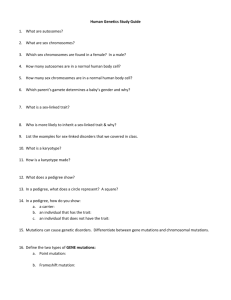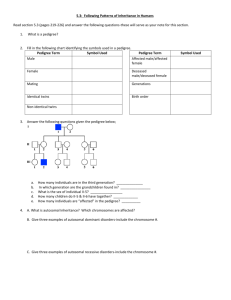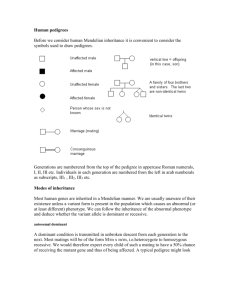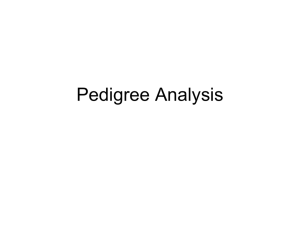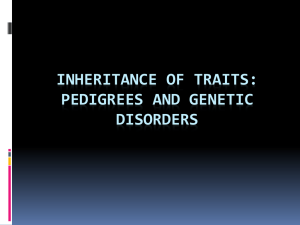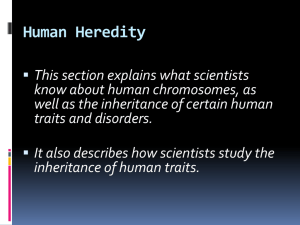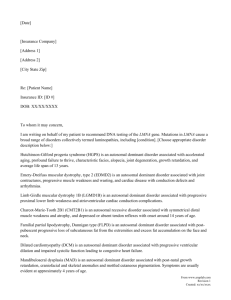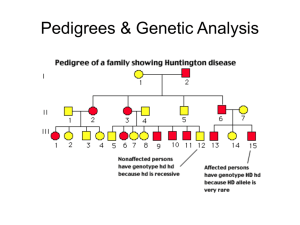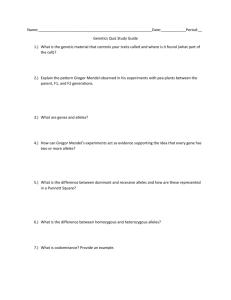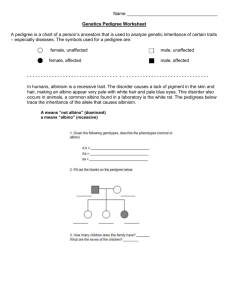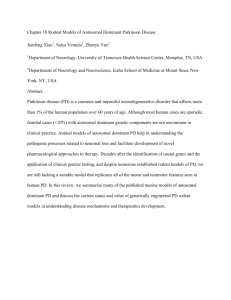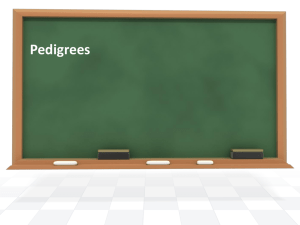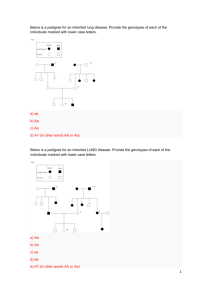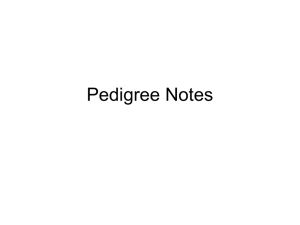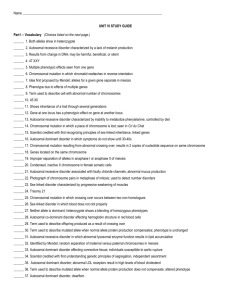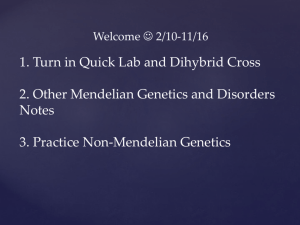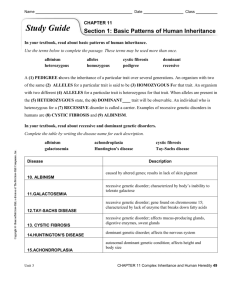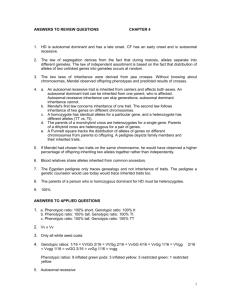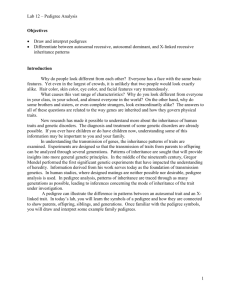Name Human Pedigree Web-quest http://www.ncbi.nlm.nih.gov
advertisement
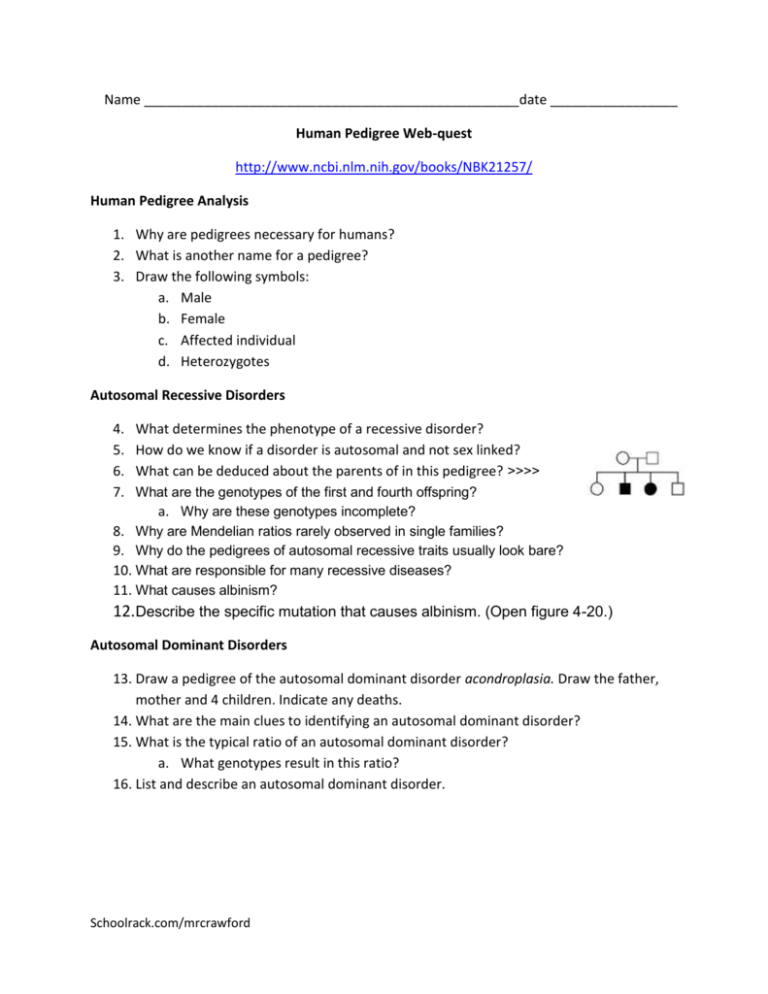
Name __________________________________________________date _________________ Human Pedigree Web-quest http://www.ncbi.nlm.nih.gov/books/NBK21257/ Human Pedigree Analysis 1. Why are pedigrees necessary for humans? 2. What is another name for a pedigree? 3. Draw the following symbols: a. Male b. Female c. Affected individual d. Heterozygotes Autosomal Recessive Disorders 4. 5. 6. 7. What determines the phenotype of a recessive disorder? How do we know if a disorder is autosomal and not sex linked? What can be deduced about the parents of in this pedigree? >>>> What are the genotypes of the first and fourth offspring? a. Why are these genotypes incomplete? 8. Why are Mendelian ratios rarely observed in single families? 9. Why do the pedigrees of autosomal recessive traits usually look bare? 10. What are responsible for many recessive diseases? 11. What causes albinism? 12.Describe the specific mutation that causes albinism. (Open figure 4-20.) Autosomal Dominant Disorders 13. Draw a pedigree of the autosomal dominant disorder acondroplasia. Draw the father, mother and 4 children. Indicate any deaths. 14. What are the main clues to identifying an autosomal dominant disorder? 15. What is the typical ratio of an autosomal dominant disorder? a. What genotypes result in this ratio? 16. List and describe an autosomal dominant disorder. Schoolrack.com/mrcrawford X-Linked Recessive Disorders. 17. List two characterisitics of sex-linked recessive triats. 18. Describe: a. Hemophilia b. Duchenne Muscular Dystrophy 19. Look at fig 4-24. a. What individual did III1 receive a recessive gene from? 20. Look at fig 4-25 a. What event in generation III may have increased the frequency of hemophilia in the royal family? b. Are the children of Prince Charles and Diana hemophiliacs? Calculating the Risks in Pedigree Analysis 21. What type of disorder is illustrated by the pedigree? (Assume it is not sex linked.) 22. What can you tell about all of the individuals in generation I, based on the results of generation II? Schoolrack.com/mrcrawford Genetics Web-quest http://www.biology.arizona.edu Select “Karyotyping.” (Far left-hand side) Read the introduction. To continue, select “Patient Histories” You will select the patient karyotypes and complete each activity associated with it. For the karyotypes, a picture of a chromosome will be displayed at the top of the page. Possible matches will be highlighted in blue. Click on the highlighted chromosome that matches the picture at the top of the page. You will be informed if you matched correctly, and will then be given another chromosome to match. You will continue matching chromosomes until the karyotype is completely filled in. Answer the questions that follow the completed karyotype on this sheet. NOTE: The first page for each patient will take a few minutes to load. Be patient. The remainder of the pages will load quickly. Patient A A.1. ___________________________________ A.2. ___________________________________ Describe patient A. How were the chromosomes for this karyotype obtained? Patient B: B.1. ___________________________________ B.2. ___________________________________ Why did Patient B originally seek the medical treatment that led to this karyotype being made? Patient C: C.1. ____________________________ C.2. ____________________________ What were patient C’s abnormalities and what happened to him? Schoolrack.com/mrcrawford Google search the following. Use only credible websites. Disorder Down Syndrome Turner Syndrome Patau Syndrome Fragile X Syndrome Cri du Chat Trisomy 18 Schoolrack.com/mrcrawford Chromosome affected Symptoms
